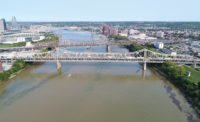Air Quality
EPA Updates Five Metro Areas to 'Severe' Smog Status, Requiring Added Protections
Proposed designations could complicate construction project permitting

Denver is one of the cities where the EPA has proposed increasing smog protections.
Photo by U.S. Dept. of Energy
Five major U.S. metro areas could be required to develop plans for reducing air pollution after the U.S. Environmental Protection Agency determined that they have failed to meet air quality standards for ground-level ozone. The proposed EPA designations for metropolitan Chicago, Dallas, Denver, New York City and Houston also could tighten permitting rules for certain projects in those areas.
The changes were outlined in a proposed rule published in the Federal Register on April 13. EPA published it to update the status of dozens of areas around the U.S. that it says have failed to meet either the 2008 or 2015 National Ambient Air Quality Standards for ground-level ozone by deadlines last summer.
Of those, EPA wants to reclassify metro Chicago, Dallas, Denver and New York City from “serious” to “severe,” the second-highest level after “extreme” on its five-level scale. The agency also wants to deny a Texas proposal to extend the deadline for the Houston area and also classify it as severe.
The 2008 standard requires an eight-hour concentration of no more than 0.075 parts per million of ozone. The 2015 standard strengthened that further to 0.07 ppm.
Ground-level ozone is formed when pollutants from power plants, cars and other sources mix with sunlight. EPA's proposed designations could have a chilling effect on economic growth and the ability to obtain some permits for new construction projects or expansions in those areas, says Melinda Tomaino, director of environmental services for the Associated General Contractors of America.
Under the federal Clean Air Act, states need to implement measures to curtail smog and protect public health when EPA reclassifies areas within them.
Those measures include expanding the list of stationary sources of emissions, such as power plants and manufacturing plants, which require preconstruction permits for any new construction or modifications. Mobile sources, including vehicles and construction equipment, also would face added emissions controls, and reformulated gasoline would need to be sold in severe areas within a year of the reclassification.
EPA's proposal says that states must submit plans on how they will achieve the standards as quickly as possible, with a deadline to reach attainment by July 20, 2027.
Restricting Growth
The designation as either a serious or severe non-attainment area could have "real consequences" for project developers and construction contractors, Tomaino says, noting increased costs and project delays because of difficulties in obtaining a permit. In areas that are trying to reduce emissions, permits for new source projects such as power plants could be difficult to obtain.
"They are not going to want to put a new source in an area that is in serious non-attainment," she says.
Moreover, federal dollars can be withheld for transportation projects until an area is able to sufficiently reduce ground-level ozone to within National Ambient Air Quality Standards limits.
EPA also has proposed classifying the area of the Morongo Band of Mission Indians, located east of the Los Angeles metro area in Riverside County, Calif., as severe, but the tribe would not be required to submit implementation plans.
The agency has taken a multifaceted approach recently to address smog, stating that more than 79 million Americans live in areas that do not meet air quality standards. Last month, EPA proposed standards to cut emissions from heavy-duty vehicles and proposed a rule to reduce nitrogen-oxide emissions from power plants and other industrial sites.
EPA will accept comments on its proposed rule for 60 days and plans to hold a virtual public hearing on May 9.





